Mongolian Information
Contents
 General Information
General Information
 History
History
 People
People
 Religion
Religion
 Back to Homepage
Back to Homepage

General Information
 Adult literacy rate is 84%(1999)
Adult literacy rate is 84%(1999)
 The public school system provides free and compulsory education for 8 yrs., starting at age 7
The public school system provides free and compulsory education for 8 yrs., starting at age 7
 Infant mortality rate is 66 per 1,000 births(1999); birth rate 3.26%, death rate .6%(1995)
Infant mortality rate is 66 per 1,000 births(1999); birth rate 3.26%, death rate .6%(1995)
 in 1995 there was an average of 4.5 children/woman
in 1995 there was an average of 4.5 children/woman
 Life expectancy = 59(men) 64(women)(1999)
Life expectancy = 59(men) 64(women)(1999)
 Population statistics for 1995: pop. Growth 2.58%, under 14 yrs 40%, over 65 yrs. 4%
Population statistics for 1995: pop. Growth 2.58%, under 14 yrs 40%, over 65 yrs. 4%
Population statistics for 1999: pop. Growth 1.5%, Mongolia has 2.57 million people
 Inflation rate = 53.1%(1995)
Inflation rate = 53.1%(1995)
 GDP per capita = US$309(underestimated because of cashless society)(1995)
GDP per capita = US$309(underestimated because of cashless society)(1995)
monthly wage = US$94 in Ulaanbaatar; US$65 in countryside(1995)
 Major exports = molybdenum, copper, sheepskins, cashmere
Major exports = molybdenum, copper, sheepskins, cashmere
the country has over 300 mines, coal is also produced but used for heat in country
 Major imports = vehicles, oil, glass, sugar, industrial equipment
Major imports = vehicles, oil, glass, sugar, industrial equipment
 before communism it was all free land, communists tried to implement collective farming and privatization, many lost their apartments and now have uneven grazing in government controlled areas
before communism it was all free land, communists tried to implement collective farming and privatization, many lost their apartments and now have uneven grazing in government controlled areas
Back to top
History
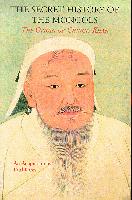
The Secret History of the Mongols reads like the Greek Odyssey. It tells the story of Chinggis' ancestors
.
 1162-1227 life of Temujin
1162-1227 life of Temujin
 1189 Temujin is given title of Chinggis Khaan(universal king). To the Mongolians he represents strength, unity, law, and order. Many of them still have pictures of him in their homes today. Before him the Mongols were a loose organization of feuding clans.
1189 Temujin is given title of Chinggis Khaan(universal king). To the Mongolians he represents strength, unity, law, and order. Many of them still have pictures of him in their homes today. Before him the Mongols were a loose organization of feuding clans.
 1211 Chinggis Khaan attacks China
1211 Chinggis Khaan attacks China
 1279 Kublai Khaan(Temujin's grandson) completes conquest of China
1279 Kublai Khaan(Temujin's grandson) completes conquest of China
 1294 Kublai Khaan dies
1294 Kublai Khaan dies
 1400-1454 Civil war in Mongolia
1400-1454 Civil war in Mongolia
 1911 Independence from China
1911 Independence from China
 1915 Russia, China, and Mongolia sign agreement to grant limited autonomy to Mongolia
1915 Russia, China, and Mongolia sign agreement to grant limited autonomy to Mongolia
 1919 Chinese invade Mongolia again
1919 Chinese invade Mongolia again
 1921 Chinese defeated
1921 Chinese defeated
 1924 the Mongolian People's Republic declared by the Communists
1924 the Mongolian People's Republic declared by the Communists
 1932 Choibalsan, following Stalin's lead, had more than 700 people, mostly monks imprisoned or murdered.
1932 Choibalsan, following Stalin's lead, had more than 700 people, mostly monks imprisoned or murdered.
 by 1939 some 27,000 people had been executed(3% of Mongolia's pop., 17,00 of which were monks)
by 1939 some 27,000 people had been executed(3% of Mongolia's pop., 17,00 of which were monks)
 1986 air services between Beijing and Ulaanbaatar, which had been suspended since the 1960's, were resumed
1986 air services between Beijing and Ulaanbaatar, which had been suspended since the 1960's, were resumed
 1989 communism collapses
1989 communism collapses
 1989 full diplomatic relations with China were established
1989 full diplomatic relations with China were established
 1992 new constitution announced, communists win election
1992 new constitution announced, communists win election
 1995 Mongolia received US$210 million in loans, major investors from 90-96 were 39% USA, 12% Japan, 12% Russia, and 10% China-much of this aid does not filter down to those in need
1995 Mongolia received US$210 million in loans, major investors from 90-96 were 39% USA, 12% Japan, 12% Russia, and 10% China-much of this aid does not filter down to those in need
 1996 Mongolian Democratic Coalition unexpectedly wins over communists ending 75 years of communist rule
1996 Mongolian Democratic Coalition unexpectedly wins over communists ending 75 years of communist rule
 1998-1999 three leaders resigned over conflicts of how to govern
1998-1999 three leaders resigned over conflicts of how to govern
 2000 new elections to be held, a Prime Minister governs currently
2000 new elections to be held, a Prime Minister governs currently
 The Mongolians have gone from pastoral nomads to the second communist state in the world for 70 years to a market economy with a democratic government. They are eager to learn new ways, but still hold to the strength of their people with many living the same as they did in Chinggis Khan's time.
The Mongolians have gone from pastoral nomads to the second communist state in the world for 70 years to a market economy with a democratic government. They are eager to learn new ways, but still hold to the strength of their people with many living the same as they did in Chinggis Khan's time.
Back to top

The People
Photo by Ohno Satoshi
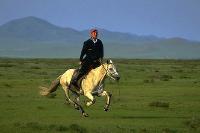
 The horse is very important to their way of life.
The horse is very important to their way of life.
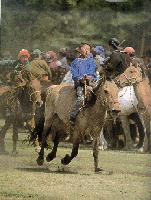
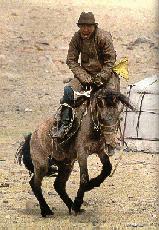
Photo on left by Adrian Arbib and Benedict Allen, photo on right by Melvyn C. Goldstein and Cynthia M. Beall
Children learn to ride as soon as they can walk. This picture, on the left, shows young riders in the Nadaam festival race. Horses are put out in the winter and "rebroke" each Spring, as shown by the enthusiastic rider on the right.
 Mongolia is also famous for a specific kind of earthreal singing. There are many types, khumaii and tuva are two names I've heard. As I learn more maybe I can update this area. I found a site on Tuva music that gives you more information than one could ever digest.
Mongolia is also famous for a specific kind of earthreal singing. There are many types, khumaii and tuva are two names I've heard. As I learn more maybe I can update this area. I found a site on Tuva music that gives you more information than one could ever digest.
 {pg. 12 in women of mongolia}
{pg. 12 in women of mongolia}
 ethnicity: 79%(1999), are Khalkh Mongols, 4%(1999) are Kazaks(most of whom live in the West and are famous for their falconry). There are 13 other smaller groups of distinct ethnicities.
ethnicity: 79%(1999), are Khalkh Mongols, 4%(1999) are Kazaks(most of whom live in the West and are famous for their falconry). There are 13 other smaller groups of distinct ethnicities.
 1/4 of the people live in Ulaanbaatar, another 1/4 live in smaller cities, the rest of the people are spread throughout Mongolia and are mostly nomadic
1/4 of the people live in Ulaanbaatar, another 1/4 live in smaller cities, the rest of the people are spread throughout Mongolia and are mostly nomadic
 The youth wear jeans and Western-style clothing. Men wear suits. In rural areas the del(a traditional wrap around gown held round the waist by a bright sash and buttoning on the upper right shoulder) is more popular, and is worn by both men and women. A winter version may be very thickly lines with fur.
The youth wear jeans and Western-style clothing. Men wear suits. In rural areas the del(a traditional wrap around gown held round the waist by a bright sash and buttoning on the upper right shoulder) is more popular, and is worn by both men and women. A winter version may be very thickly lines with fur.
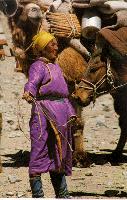 photo by Melvyn C. Goldstein and Cynthia M. Beall
photo by Melvyn C. Goldstein and Cynthia M. Beall
 Mongols enjoy having guests in their homes and are known for their hospitality.
Mongols enjoy having guests in their homes and are known for their hospitality.
 Most live in nuclear families. Elderly parents live with the family of their youngest son.
Most live in nuclear families. Elderly parents live with the family of their youngest son.
 People usually marry between 18 and 25 years of age.
People usually marry between 18 and 25 years of age.
 Back to top
Back to top

Religion
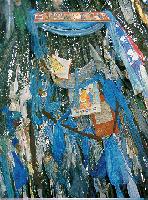 photo by Adrian Arbib and Benedict Allen
photo by Adrian Arbib and Benedict Allen
This is a photo of an ovoo. Usually a pile of rocks that travelers add stones or other bits to. This shows the integration between shaministic beliefs and Buddism coexisting.
 Tibetan Buddhism was introduced in the 7th Century
Tibetan Buddhism was introduced in the 7th Century
 1578 - Altan Khan converts to Buddhism, Mongolia had previously been mostly Shamanistic
1578 - Altan Khan converts to Buddhism, Mongolia had previously been mostly Shamanistic
 Kublai Kahn had teachers of Islam, Taoism, Nestorian Christianity, Manicheism, Confucianism, and Buddhism in his court offering advice in managing the state.
Kublai Kahn had teachers of Islam, Taoism, Nestorian Christianity, Manicheism, Confucianism, and Buddhism in his court offering advice in managing the state.
 Mongolians take Buddhism of the Tibetan Lamaist variety
Mongolians take Buddhism of the Tibetan Lamaist variety
 reincarnate lamas have been born in Mongolia
reincarnate lamas have been born in Mongolia
 1911 - when Qing China collapsed, the eighth Jebtzun Damba(he died in 1924 and was not replaced) declared Mongolia's independence and wielded sacred and secular power as did the Dalai Lama in Tibet
1911 - when Qing China collapsed, the eighth Jebtzun Damba(he died in 1924 and was not replaced) declared Mongolia's independence and wielded sacred and secular power as did the Dalai Lama in Tibet
 1921 -110,000 men(1/3 of the male population) were lamas living in about 700 monasteries. Such a lack of males in the population was not good for the communist ideal of having large populations.
1921 -110,000 men(1/3 of the male population) were lamas living in about 700 monasteries. Such a lack of males in the population was not good for the communist ideal of having large populations.
 1937 - the purge began and only 4 monasteries remained as museums, today new ones are being built, and old ones(where anything is left) are being restored.
1937 - the purge began and only 4 monasteries remained as museums, today new ones are being built, and old ones(where anything is left) are being restored.
 1997 - there were only 1000 lamas in 30 monasteries
1997 - there were only 1000 lamas in 30 monasteries
 5% of Mongolia today is Islamic, but it's mostly Kazaks
5% of Mongolia today is Islamic, but it's mostly Kazaks
 there are 30 non-Buddhist places of worship
there are 30 non-Buddhist places of worship
 Shamanism is still practiced, and co-exists with Buddhism.
Shamanism is still practiced, and co-exists with Buddhism.
Back to top

~ calendar ~ where I am ~ general info ~
~ photo album ~ language ~ housing ~ food ~
![]()
![]() Adult literacy rate is 84%(1999)
Adult literacy rate is 84%(1999)![]() The public school system provides free and compulsory education for 8 yrs., starting at age 7
The public school system provides free and compulsory education for 8 yrs., starting at age 7![]() Infant mortality rate is 66 per 1,000 births(1999); birth rate 3.26%, death rate .6%(1995)
Infant mortality rate is 66 per 1,000 births(1999); birth rate 3.26%, death rate .6%(1995)![]() in 1995 there was an average of 4.5 children/woman
in 1995 there was an average of 4.5 children/woman![]() Life expectancy = 59(men) 64(women)(1999)
Life expectancy = 59(men) 64(women)(1999) ![]() Population statistics for 1995: pop. Growth 2.58%, under 14 yrs 40%, over 65 yrs. 4%
Population statistics for 1995: pop. Growth 2.58%, under 14 yrs 40%, over 65 yrs. 4% ![]() Inflation rate = 53.1%(1995)
Inflation rate = 53.1%(1995)![]() GDP per capita = US$309(underestimated because of cashless society)(1995)
GDP per capita = US$309(underestimated because of cashless society)(1995)![]() Major exports = molybdenum, copper, sheepskins, cashmere
Major exports = molybdenum, copper, sheepskins, cashmere![]() Major imports = vehicles, oil, glass, sugar, industrial equipment
Major imports = vehicles, oil, glass, sugar, industrial equipment![]() before communism it was all free land, communists tried to implement collective farming and privatization, many lost their apartments and now have uneven grazing in government controlled areas
before communism it was all free land, communists tried to implement collective farming and privatization, many lost their apartments and now have uneven grazing in government controlled areas




